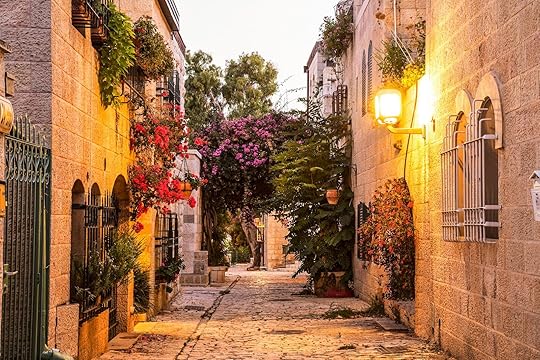Matador Network's Blog, page 420
September 7, 2022
These Tampa Airbnbs Put You Near Downtown, Busch Gardens, and the Waterfront

The city of Tampa is truly a hidden gem and filled with many activities, experiences, and things to get into. If you’re looking for a place where you can have peaceful days as well as jam-packed eventful days then Tampa Florida is the place to be. Enjoy a morning walk on The Riverwalk, explore Downtown Tampa, or take friends and family to the aquarium or Busch Gardens. Visiting Tampa there will always be things to do and beautiful Airbnb Tampa rentals to stay at.
Traveling to Florida? Check out Matador’s Florida accommodations guides:15 beautiful Florida Airbnbs for every type of travelerThe best 11 Airbnbs near Universal StudiosThe 12 best Miami Airbnbs from South Beach to Little Havana8 of the coolest Airbnbs near Disney World, Florida15 beautiful Florida Airbnbs for every type of traveler6 Kissimmee Airbnbs for a multi-generational family Disney trip11 Key West Airbnbs to experience the best of the island11 gorgeous Florida Keys Airbnbs to catch the ‘Keys Disease’These New Smyrna Beach Airbnbs showcase the best of Florida’s central coast
We hope you love the Airbnb Tampa vacation rentals we recommend! Just so you know, Matador may collect a small commission from the links on this page if you decide to book a stay. Listed prices are accurate as of the time of publication.
Tampa Airbnbs with a private poolTampa Airbnbs near Busch GardensTampa Airbnbs near Downtown TampaTampa Airbnbs with a waterfront viewsTampa Airbnbs with a private poolSpacious home with enclosed pool in Hampton Terrace
Photo: Airbnb

Photo: Airbnb

Photo: Airbnb

Photo: Airbnb

Photo: Airbnb
Check out this peaceful and spacious Tampa Airbnb in the heart of Hampton Terrace. This family home has three bedrooms, a spacious living room, a screened-in patio with a pool, and a well-equipped kitchen. This home has the best of both worlds with its peaceful and quiet location and the perfect location near top Tampa attractions like downtown, the Tampa Stadium, and the casino.
Six guests, three bedrooms
Price: $169 per night

Photo: Airbnb

Photo: Airbnb

Photo: Airbnb

Photo: Airbnb

Photo: Airbnb
Sit back and relax at this cozy Tampa vacation rental. This newly renovated bungalow has everything you need and more. This bungalow is in Tuckaway Grove, the perfect vacation spot for your getaway. This 1,500-square-foot bungalow has many unique touches, like a brick paved backyard garden and a cooling saltwater pool. Another perk is that this bungalow is just a couple of blocks away from Tampa’s famous bars including the Lowry Parcade.
Six guests, three bedrooms
Price: $231 per night

Photo: Airbnb

Photo: Airbnb

Photo: Airbnb

Photo: Airbnb

Photo: Airbnb
Here’s the perfect home for your Tampa getaway. This beautiful Tampa home features a spacious living area with a large window to bring in the warm Florida sun, a fully equipped kitchen with all appliances, a table for six, and a work office space. If you want to take some memories back home with you, there is an Instagram wall for all your selfie needs. Enjoy the tropical vibes and relax in the spacious pool, or hang out in the outdoor area with hammocks, a fire pit, and lounge chairs and cook up some things on the grill in the outdoor dining area.
Seven guests, three bedrooms
Price: $221 per night

Photo: Airbnb

Photo: Airbnb

Photo: Airbnb

Photo: Airbnb
If you are looking for a spacious family home for your Tampa getaway, check out this centrally located home with enough space for the whole family. This modern home has four bedrooms, five bathrooms, three baths, a spacious living room, a dining room, and a backyard so the kids can run around. The home is ten minutes from Busch GardenAdventure Island, Lowry Park Zoo, and more.
Eight guests, four bedrooms
Price: $190 per night

Photo: Airbnb

Photo: Airbnb

Photo: Airbnb

Photo: Airbnb

Photo: Airbnb
Enjoy this new Airbnb Tampa oasis for your next Florida getaway. This home has a spacious living area and kitchen area perfect for cooking meals for the family for a night in and large bedrooms for everyone. Chill out and lounge in the pool and the private backyard. The home is the ideal location for access to family-friendly attractions, and if you’re looking to take an adventure out to other places, Clearwater Beach is just an hour away.
Eight guests, three bedrooms
Price: $149 per night

Photo: Airbnb

Photo: Airbnb

Photo: Airbnb

Photo: Airbnb
Stay in this hidden Tampa gem with a large backyard great for hangouts, along with a dining table and a BBQ grill. Enjoy the home inside and relax in the living room with two couches that convert into two queen-sized beds for additional sleeping. Take advantage of the convenience as the house is just a two-minute drive to Busch Gardens and 12 minutes away from the University of Tampa, Amalie Arena, Cruise ports, Curtis Hixon park, Hyde Park, and Channelside.
Ten guests, one bedroom
Price: $122 per night

Photo: Airbnb

Photo: Airbnb

Photo: Airbnb
Right in the heart of Downtown Tampa is this modern apartment. This spacious unit is within walking distance to many Downtown Tampa attractions like the Riverwalk, Amalie Arena, Straz Center, and the Florida Aquarium.
Three guests, one bedroom
Price: $90 per night

Photo: Airbnb

Photo: Airbnb

Photo: Airbnb

Photo: Airbnb
Experience a little of Tampa’s posh side with this Channelside luxury apartment. This apartment includes a spacious living room and a fully equipped kitchen. If you need to work while in the unit, there is a work desk area. The apartment amenities include a pool, a 2,700-square-foot gym, a yoga and spinning room, social lounge, a cyber cafe (remember those? Now more commonly known as coworking spaces), and more. This apartment is within walking distance.
Six guests, two bedrooms
Price: $207 per night

Photo: Airbnb

Photo: Airbnb

Photo: Airbnb

Photo: Airbnb
Take a break from reality at this relaxing waterfront Airbnb in Tampa. This studio is on the water and gives a stunning view of the lake. The studio has a large living area that features a queen bed, a couch, and a kitchenette area, along with a full bath. Head out to the back deck and nap on the lounge chairs, chill out by the fire pit, cook out on the grill and enjoy the sounds of the water.
Five guests, one bedroom
Price: $86 per night

Photo: Airbnb

Photo: Airbnb

Photo: Airbnb

Photo: Airbnb

Photo: Airbnb
Escape to this riverside guesthouse hidden away in Seminole Heights. Relax in the spacious living room with a river view, cook a meal in the kitchen, or take a nap in the private bedroom. Enjoy the Florida sun and listen to the sounds of the soothing water while swinging in the hammock. 
Two guests, one bedroom
Price: $90 per night
People Who Send Airline Complaints Through Twitter Are Getting Scammed

Useful rule of thumb If someone on Twitter asks you to send money to Kenya to get a bag that was mishandled on your flight from London to Miami, it’s probably a scam.
Some unfortunate travelers learned this lesson the hard way this summer, though, as scammers took full advantage of the Summer of Lost Luggage and preyed on people’s desperation. As reported by The Independent, a Twitter account pretending to be British Airways customer service contacted people who’d tweeted at the airline about their lost luggage, and then conned them out of cash.
The fake account — @CareBritish — would respond to complaints asking for personal information like phone numbers and emails before requesting payment to return the mishandled bags. Of course, the luggage never showed, so the imposters asked for even more money to have the issues ironed out. They requested the money be sent to an account in Kenya, when flights went nowhere near that country. Ultimately, this twitter scam bilked out some people of nearly a thousand dollars.
This raises all kinds of red flags, as no airline in the history of checked luggage has ever requested money to return a bag. Further, airlines don’t have unverified Twitter accounts that handle their customer service requests. Nor do they have bank accounts on other continents that handle payments. Still, when you’re desperate to get your bags back and BA isn’t responding because they have an airport full of lost luggage to deal with, maybe scam detectors get a little dull.
So, if you do opt to go on Twitter to inquire about a lost bag, only respond to a verified account from the airline you reached out to. Remember, they’ll never ask for money to have a bag returned as it’s their responsibility to get it back to you. Lost luggage can be stressful, yes, but airlines have all sorts of rules they need to follow when they lose your bag, and typically they’ll be the ones paying you. Stay diligent, even when it feels like you may never see your suitcase again. 
These Airbnbs in Portland, Maine, Showcase the Best of New England’s Coolest City

You might be surprised by how much there is to do in the compact seaside town of Portland, ME. Since developing into a booming fishing port in the 19th century, modern-day Portland is swimming in art galleries, seafood diners, and oceanside parks. Six of Maine’s 200 lighthouses are located on the periphery of this prominent port city. In terms of where to stay in Portland, you can choose between renovated heritage properties right in the heart of downtown or seaside digs. Here’s our guide to the top-rated Airbnb Portland, Maine vacation rentals.
Traveling to New England? Check out Matador’s New England accommodations guides:The Best Airbnbs in Boston, From Beacon Hill To a Ship in the HarborChannel Your Inner Thoreau With a Solo Retreat at These Remote New England Airbnbs11 New England Lighthouses You Can Actually Spend the Night In9 Great Killington Airbnbs for Your Adventure Weekend in Vermont
We hope you love the Airbnb Portland, Maine, vacation rentals we recommend! Just so you know, Matador may collect a small commission from the links on this page if you decide to book a stay. Listed prices are accurate as of the time of publication.
Most Unique Airbnb in Portland, MaineAirbnbs in Portland, Maine – Old Port with terracesWalk anywhere from these Airbnbs in downtown Portland, MaineBest Munjoy Hill Airbnbs, Portland, MaineAirbnbs in South Portland, Maine near the oceanfrontMost Unique Airbnb in Portland, MaineSixteen-acre private island venue, seven luxury campsites
Photo: Airbnb

Photo: Airbnb

Photo: Airbnb

Photo: Airbnb
Retreat offshore to this private island Airbnb Portland, Maine. The complex is spread across the grounds of civil war-era Fort Scammel and you’ll have free reign of the bastion and tunnels. All seven yurts are kitted out with double beds with select units having an additional pull-out trundle. Larger groups are permitted to pitch up to ten further tents on the island. Terraces and firepits are set up so you can kick back with a skyline view come dusk.
Sixteen guests, seven bedrooms
Price: $5,000 per night

Photo: Airbnb

Photo: Airbnb

Photo: Airbnb

Photo: Airbnb
This sophisticated Portland penthouse tops an old 1850s warehouse in the Old Port with views over Dimillo’s Marina. Step out onto the private deck and watch the yachts come and go with your nearest and dearest and huddle in front of the gas stove in cooler months. Interiors are stylishly presented with exposed beams and brickwork, vaulted ceilings, and skylights in the bedrooms. Feel inspired to cook up a storm in the state-of-the-art kitchen or switch off with a long soak in the luxurious bathtub.
Four guests, two bedrooms
Price: $550 per night

Photo: Airbnb

Photo: Airbnb

Photo: Airbnb

Photo: Airbnb
Rising above the waterfront, this Portland, Maine, Old Port Airbnb loft grants terrific panoramic views while natural light pours in from the skylights. The space is equipped for short and long stays with a complete kitchen, comfy bed, and ample seating. Best of all, the apartment has a deck where you can top up your tan over a morning brew.
Two guests, one bedroom
Price: $340 per night

Photo: Airbnb

Photo: Airbnb

Photo: Airbnb

Photo: Airbnb
Renovated to satisfy modern travelers without sacrificing its original charms, this 19th-century Georgian Revival townhouse will delight old souls. Neat touches include a rainfall shower in one bathroom, a vintage tub in another, and a fully fenced garden with a barbecue. Two of the bedrooms are designed for kids with various toys to keep them entertained. Chuck a couple of logs on the wood burner when night draws in and unwind in this restful family dwelling.
Seven guests, five bedrooms
Price: $1,050 per night

Photo: Airbnb

Photo: Airbnb

Photo: Airbnb

Photo: Airbnb
You’ll have the best of the city at your fingertips while staying at this downtown Portland, Maine, Airbnb. Painted a fetching cerulean blue, the property is within walking distance of the waterfront, museums, and galleries. Spread over two floors and with the added bonus of a rooftop sun terrace, there’s sufficient space to avoid feeling on top of each other. Presented like a proper home, this rental is perfect for families.
Twelve guests, five bedrooms
Price: $2,200 per night

Photo: Airbnb

Photo: Airbnb

Photo: Airbnb

Photo: Airbnb
Conveniently located in the Arts District, this charming two-bedroom condo sets out to impress with its sun-kissed curved lounge. A statement fireplace is poised to keep winter travelers feeling toasty while hardwood floors are draped with cozy rugs. With excellent kitchen facilities and thoughtful workspaces, this is one of the best Portland, Maine, Airbnbs for remote workers. Exterior space includes a patio and backyard shrouded with greenery.
Four guests, two bedrooms
Price: $1,000 per night

Photo: Airbnb

Photo: Airbnb

Photo: Airbnb
Steps away from the attractions, renting this downtown Portland, Maine, Airbnb comes with the exclusive use of your own outdoor hot tub. The studio space is roomy enough to accommodate a couple with a light-filled seating zone and a fully-equipped kitchen providing home comforts. You’ll note that the host, a seasoned traveler, is an avid art collector. Pieces are rotated frequently to revitalize the space.
Two guests, one bedroom (studio)
Price: $340 per night

Photo: Airbnb

Photo: Airbnb

Photo: Airbnb

Photo: Airbnb
Artfully constructed and decorated, this boutique townhouse is spread over three levels with original wooden flooring, exposed beams, and fine furnishings. Trinkets, books, and board games add a personal layer to the vacation rental, and, yes, you are more than welcome to borrow anything you spot on the shelves. Gather the clan in time for sunset and savor sundowners on the roof patio with postcard views over Munjoy Hill and Casco Bay.
Six guests, three bedrooms
Price: $1,240 per night

Photo: Airbnb

Photo: Airbnb

Photo: Airbnb

Photo: Airbnb
Set within a 100-year-old building, this lavish Munjoy Hill Portland, Maine, Airbnb has ocean views that you can enjoy from not one but two terraces. The upper level is accessible via a dainty spiral staircase. Interiors are tastefully appointed with elegant columns, chandeliers, and a snug book nook. When you can bear to leave, the East End is home to dozens of breweries, distilleries, and casual coffee shops.
Four guests, two bedrooms
Price: $555 per night

Photo: Airbnb

Photo: Airbnb

Photo: Airbnb

Photo: Airbnb
This oceanfront Airbnb Portland, Maine, is suitable for larger groups seeking a mellow base while in town. Interior spaces are a fusion of country-chic and beach house decor. A gourmet kitchen marks the heart of the house while spacious communal areas and guest suites are fitted with cushy sofas and high-quality linens. Head up to the rooftop deck for a view of the ocean while you decompress in the therapeutic massage hot tub.
Eleven guests, four bedrooms
Price: $1,195 per night

Photo: Airbnb

Photo: Airbnb

Photo: Airbnb

Photo: Airbnb
Fido will receive a warm welcome at this dog-friendly South Portland, Maine, Airbnb. Perfect for a couple, the studio overlooks Casco Bay and is mere moments from Willard Beach, Fort Preble, and Spring Point Ledge Lighthouse. After a hike or dip, you can laze on the sky chair – or in the fenced garden – while listening to the crash of waves. 
Three guests, one bedroom (studio)
Price: $300 per night
This New Dashboard Tells You What You’re Entitled To if an Airline Cancels Your Flight

While summer travel is finally slowing down, fall and winter travel can come with its own challenges, especially during the holiday season. Overbooked flights, bad weather, staffing shortages, and pandemic surges have created an entirely new travel landscape that consumers must learn to navigate. To help out, the US Department of Transportation’s Office of Aviation Consumer Protection (OACP) has stepped in to make it easier for consumers to understand delay and cancellation policies from each United States airline with its Airline Customer Service Dashboard.
This dashboard lays out policy questions to ensure travelers have accessible information about what airlines promise they’ll cover if there’ a controllable delay or cancellation. Controllable flight cancellation or delay is when the delay or cancellation is caused by something within the airline’s control — such as maintenance issues, crew problems, cabin cleaning, and more. These services include whether the airline will rebook passengers on the same and/or different airlines at no additional cost, provides coverage for meals, covers cancellations or delays that are three or more hours, complimentary hotel accommodations, and complimentary ground transportation.

Photo: United States Department of Transportation

Photo: United States Department of Transportation
Hopefully, this easy to read information means more understanding of passenger rights and less scrolling through the fine print of every airline you fly with.
The airline dashboard makes it clear, however, that these commitments do not impact the right to a refund you already have. Airlines must provide a prompt refund if it cancels or makes a significant change to the flight, even if the ticket is non-refundable, if the passenger chooses not to accept the airline’s alternatives. If the delay or cancellation is due to something out of the airline’s control, be sure to check with the airline’s contract of carriage to you know what you qualify for. 
September 6, 2022
10 of the Best Colorado State Parks for Avoiding National Park Crowds

There’s a near-endless list of ways to play outdoors waiting in Colorado’s 23 million acres of public land, covering everything from prairies to mountain peaks. Travelers can paddle the day away on aquatic adventures or escape into the wilderness for a few days on a backcountry expedition in one of 42 parks in the state.
The best state parks in Colorado are as diverse as the Centennial State’s topography, scattered throughout the state’s varied landscapes. All are open year-round and managed by the Colorado Parks and Wildlife Commission, established way back in 1897. Colorado’s oldest state park is Lathrop State Park, opened in 1962, and the newest is Fishers Peak State Park, which opened in late 2020.
Colorado’s parks have thousands of miles of hiking and biking trails, but the best Colorado state parks have a much wider array of outdoor experiences. At the parks below, visitors can see bald eagles soar (and potentially spot moose), sleep in yurts, go fly or lure fishing, stand in a waterfall’s mist, kayak on smooth lakes, or turn up the adrenaline with wakeboarding sessions and multi-pitch rock climbing.
Barr Lake State ParkGolden Gate Canyon State ParkRoxborough State ParkMueller State ParkLory State ParkState Forest State ParkPearl Lake State ParkSteamboat Lake State ParkRifle Falls State ParkNavajo State Park Camping in Colorado state parks Colorado state parks permits and passes Map of the best Colorado state parksWith 42 state parks, deciding which are the best state parks in Colorado is a matter of opinion. But that said, the parks below are all highly rated and in some of the prettiest places in Colorado, including along the state’s world-famous Rocky Mountain ridgelines. While outdoor enthusiasts and Colorado residents will undoubtedly want to check all 42 parks off their travel lists at some point, the 10 parks below are great places for a few first visits to Colorado’s fantastic public lands.
The best state parks in ColoradoBarr Lake State Park
Photo: Jennifer Broome
Take binoculars to this 1,900-acre prairie reservoir near Brighton, about 30 minutes from downtown Denver. It’s one of the best Colorado state parks for spotting bald eagles, especially during winter nesting.
Boating, birding, and boardwalks sum up this state park. Visitors can fish, paddle, and boat on the northern half of the lake, and the southern half is a nature refuge with boardwalks and gazebos for wildlife viewing. Barr Lake State Park is a birding hotspot in the state, known for waterbirds, shorebirds, raptors, and songbirds; more than 350 species of birds have been seen in the park. Dawn and dusk are generally the best times to see wildlife.
Walking along the boardwalk feels more like being in South Carolina or Louisiana, save for the bald eagles soaring across massive mountain summits in the distance. The park hosts an annual Bald Eagle Festival in early February (and a birding festival in early September). Eagle viewing is best in winter, but travelers visiting on weekends between mid-May and September can ride the small “Eagle Express” trolley on a naturalist-guided tour.
The park has biking, hiking, and horseback riding on the 8.8-mile multi-use trail surrounding the lake. Parkgoers can also test their bow-and-arrow skills at the archery land, aiming at targets varying from 10 to 100 yards away.
For a high-tech outdoor adventure, go on a mission with the Agents of Discovery app for iPhone or Android. It’s an educational app with augmented reality trail “missions” at 13 of the best state parks in Colorado, including Barr Lake. Download the Agents of Discovery app and mission before getting to the park because cell service can be sketchy.
Golden Gate Canyon State Park
Photo: Jennifer Broome
This mountain getaway is just 30 miles west of Denver and is one of two state parks with both cabin and yurt accommodations (five cabins and two yurts). With 11 trails, each named after an animal, it’s the best Colorado state park for high-country hiking close to the Denver Metro Area, with 12,000 acres of mountains, meadows, and forested terrain.
Visitors can hike to the Panorama Point Scenic Overlook for a 100-mile view of the Continental Divide on a clear day. The park also has several hikes to pioneer homesteads, including the homestead of early settler John Frazer, whose life is often used as an example of the tough conditions experienced in the late 1800s. And near the park’s Bootleg Bottom Picnic Area is a moonshine cabin used during Prohibition in the 1920s.
For a good family hike, explore Forgotten Valley. The valley holds a ranch house dating to 1876, where travelers can relax in one of the serene setting’s porch swings or walk down to the pond to fish.
Hunting and rock climbing are permitted in the park, and winter brings cross-country skiing, snowshoeing, sledding, ice fishing, and ice skating when the park is covered with snow. And around December, the park is home to a Christmas tree cut (so get a permit in advance). The park is a great leaf-peeping destination in the fall, and it’s possible to occasionally see moose and mountain lions (but keep a safe distance from wildlife).
Roxborough State Park
Photo: Adam Springer/Shutterstock
Roxborough is the best of the state parks in Colorado for dramatic red-rock formations like Colorado’s famed Red Rocks, about a 45-minute drive southwest of Denver. The park’s jagged, million-year-old sandstone monoliths are the same formation as the iconic amphitheater.
This is Colorado’s first state park to achieve the Leave No Trace Gold Standard from the Center for Outdoor Ethics, and guests can sit in on monthly Leave No Trace table talks to learn more about the seven principles of recreating responsibly.
Roxborough is also a Colorado Natural Area, a National Natural Landmark, and an Audubon Society Important Bird Area. Because of these designations and the fragile ecosystem across the park’s 4,000 acres, pets, rock climbing, and camping are not allowed, and biking is restricted to main roads. The park also has guided naturalist activities, including meditative walks, photography workshops, and moonlight hikes.
Mueller State Park
Photo: Richard G Smith/Shutterstock
In the shadow of iconic Pikes Peak are more than 5,000 acres of forest, meadows, and massive granite rock formations in Mueller State Park. Visitors can stay in one of three log cabins, but for the best view of the Continental Divide, book a spot in the campground.
This is one of the best state parks in Colorado for birders and wildlife watchers as it is home to black bears and mountain lions, plus more than 100 species of birds. So the odds are excellent for spotting something for travelers with a keen eye.
In July and August, Mueller State Park is bursting with a colorful palette as wildflowers dot the mountain meadows, and year-round, it’s a great park for fun after dark. The Colorado Springs Astronomical Society regularly hosts star parties at the park, open to the public. Be sure to dress warmly and try to arrive before dark as headlights can make it hard for attendees’ eyes to adjust to the darkness.
Lory State Park
Photo: Nature’s Charm/Shutterstock
This small-but-mighty state park is just a 15-minute drive from downtown Fort Collins. It’s just under 2,600 acres, but it’s a foothills gem in the northern Front Range with 26 miles of biking, horseback riding, and hiking trails. Some trails, like popular Arthur’s Rock, are designated as hiking-only, so check the map in advance if planning to bike. The Arthur’s Rock trail goes through pine forests and across sloping meadows before reaching a rock outcropping with a stunning view of Horsetooth Reservoir, Fort Collins, and plains to the east.
In addition to the 20-plus miles of bike trails, mountain bikers should check out the Corral Center Mountain Bike Park, with close to 70,000 square feet of skills areas, pump tracks, jumps, drops, and more. Bouldering and rock climbing are also allowed throughout the park; climbers should pick up a route guide from the park visitor center. And non-motorized paddlers can launch personal watercraft from several coves on the Horsetooth Reservoir, but motorized watercraft aren’t allowed.
State Forest State Park
Photo: Colorado Parks and Wildlife Commission
Moose are this Colorado park’s claim to fame as it’s a high-country haven surrounded by forest in northern Colorado. It covers 71,000 acres of diverse landscapes, including glacial-carved cirques, endless meadows, and sand dunes. With an estimated moose population of around 600, it’s considered the best of the state parks in Colorado for spotting the gangly mammal.
Because it’s so large, it’s a great place to find solitude in nature, especially along the west side of the Medicine Bow Mountains and the northern end of the Never Summer Range. In summer and fall, the park is open for hiking, biking, and riding four-wheel vehicles. Some of the park’s best hikes lead to Agnes, Kelly, and Clear alpine lakes, the trails for all of which showcase the geological beauty of the park’s craggy landscape. Be aware when visiting in the fall that the park is a sought-after hunting destination.
Since the park is a little more remote than most, it’s a great place to spend the night. State Forest State Park has four campgrounds, cabins, and yurts, but designated dispersed and backcountry camping is also allowed. Travelers who don’t have their own gear for sports like geocaching, snowshoeing, or fishing can rent everything they need at the Moose Visitor Center, though Never Summer Nordic manages the yurt rentals.
Pearl Lake State Park
Photo: Teri Virbickis/Shutterstock
North of Steamboat Springs at the base of Farwell Mountain in Routt National Forest is pristine Pearl Lake State Park. It’s known for wakeless water and is one of the best state parks in Colorado for kayak camping trips along the shoreline. Of course, it’s also a good spot for a picnic and a few hours of low-tech lake fun as there’s no cell service.
Anglers can fly and lure fish for native cutthroat trout and grayling, and hikers will enjoy the dazzling display of quaking golden aspens come fall. Winter calls for snowshoeing, cross-country skiing, or ice fishing, likely with few other guests around. The park has 36 campsites that close in winter, but the two lakeview yurts are open year-round (and require a minimum two-night stay from May through October). It’s an excellent state park to combine with a Steamboat Lake State Park visit, especially on a day trip to see fall colors along ultra-scenic Highway 129 in late September or early October.
Steamboat Lake State Park
Photo: Colorado Parks and Wildlife Commission
Head north from Pearl Lake to much the larger Steamboat Lake State Park to visit two of the best state parks in Colorado on one trip. The scenic lake has stellar views of Hahns Peak and the Park Range from its position at 8,100 feet above sea level.
There are seven miles of trails for hikers and bikers (which connect to a trail system in abutting and Routt National Forest), but the star of the park is the lake. Motorboats, jet skis, sailboats, and hand-powered crafts are all allowed on the 1,100-acre lake from spring to fall. Wildlife also love the area; visitors can often spot deer and elk. But it’s also possible to glimpse sandhill cranes, bald eagles, ospreys, bears, and foxes.
Fall colors are stunning in the park, and during winter, there’s a nordic ski touring center with groomed trails for cross-country skiers. Snowshoers are also welcome, though there are no on-site rentals.
Campground reservations are highly sought after on summer weekends, so book well in advance.
Rifle Falls State Park
Photo: Colorado Parks and Wildlife Commission
A 70-foot-high triple waterfall is the star attraction in this state park near Rifle, especially as it’s one of the most accessible falls in Colorado.
The spectacular setting of the thunderous falls surrounded by moss-covered rocks and lush foliage draws in photographers and movie crews from around the world. It’s a small state park with only three hiking trails, but there’s a lot to see. Parkgoers can meander through a lush riparian habitat along East Rifle Creek to an overview at the top of the falls or fish for trout in the creek; the Rifle Falls Fish Hatchery is just a mile from the falls.
Adventurous types can explore caves in the limestone cliffs behind the falls off the park’s Coyote Trail. It’s best to book camping as far in advance as possible as there are only 13 drive-in and seven walk-in campsites.
Navajo State Park
Photo: Colorado Parks and Wildlife Commission
This is one of the best state parks in Colorado for watersports as the spectacular setting in Southwest Colorado is often dubbed “Colorado’s Lake Powell.”
Navajo Reservoir is near Durango and extends 20 miles south into New Mexico. So with 150 miles of shoreline and 15,000 surface acres of water, the park is a house-boater or motorboater’s dream. On land, visitors can camp under the starry skies in primitive tent sites or at full-service hookup spots. There are also three two-bedroom log cabins available for overnight stays.
Colorado wildlife abounds at this park, and the Sambrito Wetlands are a prime area for seeing muskrats, river otters, jackrabbits, and other wildlife. In the rivers, anglers can expect to find crappie, trout, bluegill, catfish, northern pike, and large-mouth and small-mouth bass. The park does get more than 300,000 visitors a year, making it a major recreational area in southwestern Colorado, but because of the park’s large size, it’s easy to find solitude on the water.
Visitors can rent pontoon boats or paddleboards from Two Rivers Marina, and inspection for invasive species is required before launching personal watercraft. The boat ramp is closed from December through February, but Navajo Reservoir typically doesn’t freeze, making for excellent bald eagle viewing in the winter.
Camping in Colorado state parks
Photo: Suzie Dundas
There are more than 4,000 campsites available in the Colorado state parks system for travelers who want to sleep under the stars, as well as seven state parks with cabins and six with yurts. But since there are only 40 cabins and ten yurts available, guests will want to reserve ahead of time through CPW’s camping reservations website. Reservations are required at all Colorado state parks at all times, except for seasonal first-come, first-served sites at Pearl Lake, Steamboat Lake, and Yampa River state parks.
Colorado state park passes and permits
All anglers will need fishing permits within Colorado state parks. Photo: Colorado Parks and Wildlife Commission/Wayne D. Lewis
Visitors need a pass to visit any of the state parks in Colorado. Daily vehicle park passes range from $9 to $11 and annual park passes range from $80 to $120, with some discounts available. Starting in 2023, Colorado residents can get a $29 “Keep Colorado Wild Pass” that includes a park vehicle pass.
There are also regulations for anglers, hunters, and boaters. Many of the streams around the best state parks in Colorado are designated as “Gold Medal Waters,” meaning they offer the best fishing in the state – so anglers flock to Colorado. But anglers will need a fishing license before casting their lines.
Hunting licenses are also required and boaters must undergo a boat inspection and get an ANS Stamp for any towed or motorized watercraft to prevent the spread of aquatic nuisance species. 
Map: The Peak Time for Leaf Peeping in Each Region of the United States

It might still be scorching hot in some parts of the country, but the excitement for fall is in full swing. And if you’re lucky enough to live in a state where the seasons truly change, nature’s sign that we’ve made it to the beloved season is that the leaves start to change. SmokyMountains.com, which releases leaf peeping forecasts each year, recently released its annual report that predicts peak fall colors in each region of the United States.
Northern areas of the US close to Canada are expected to change as early as the second week of December, including in northern Washington, Idaho, Montana, North Dakota, Minnesota, and Wisconsin. Upstate New York and other parts of the East Coast will also begin to change. During the following week of September 12, those same areas are expected to get patchy, while minor changes will start in a few counties in California, Arizona, Utah, Colorado, and Wyoming, along with almost all of the East Coast.
The rest of the country will follow the North’s lead the first week of October. By the week of October 10, only Southern states like Texas, Louisiana, Mississippi, Alabama, Georgia, and Florida will be holding out on changing leaves. But by Halloween, the entire country is expected to have gone through some optimum leaf peeping period, with a substantial majority of the country near or past peak.
While the system could never be 100 percent accurate, to predict when the leaves would change, SmokyMountains.com used historical temperature and precipitation levels, along with NOAA forecasted temperature and precipitation. It also analyzed tree species in each region, the historical trends of leaf changes in each area, and user data. Leaf enthusiasts can also report leaf changes in real-time on the SmokyMountains.com website.
If you’re looking to get a tour of the changing leaves, fall train rides are a great way to see it all or you could try a hot air balloon ride to see it from up high.
The 7 Best Old-School Italian Restaurants in New York City’s Little Italy

Manhattan’s Little Italy has been one of the most popular New York City tourist attractions for more than 50 years, whether visitors are stopping by for cannoli or to experience the legendary San Gennaro festival. The majority of the two dozen New York City Little Italy Italian restaurants, bakeries, and specialty shops in the neighborhood are located along the three blocks of Mulberry Street between Canal and Broome. Whether you start your journey along Mulberry from Canal or Broome, you’ll be greeted by a large “Welcome to Little Italy” sign which extends over each gateway (sometimes lit up by green, white, and red lights of course) to this busy three-block pedestrian-dominated thoroughfare, where cars are generally looked upon as unwanted intruders.
Every day from noon to midnight, gregarious hosts stand at their posts outside restaurant doors, often with menus in hand, looking to lure in gawkers. Visitors come to the neighborhood to see where The Irishman was filmed and then sit down for pizza, pastries, or pasta. Souvenir shops are as much a part of the scenery as the outdoor dining pods that have stayed in place since COVID.
Despite the heavy tourist presence here, locals still frequent their favorite New York City Little Italy Italian restaurants, whether it be late-19th-century landmarks like Caffe Roma and Puglia or newcomers like Pep’s on Grand. And so do people who left the neighborhood decades ago for New Jersey, Long Island, or the outer boroughs.
And while many old-school Italian restaurants in the outer boroughs are inconveniently located and notoriously challenging to get a table at, it’s impossible not to get a table in Little Italy. On the surface, the restaurants may seem indistinguishable from one another. Most are named after a region of Italy or begin with ‘La’ or ‘Da. You’re unlikely to have a bad meal at any restaurant within the three densely-packed blocks, but here are seven must-try New York City Little Italy Italian restaurants.
The best New York City Little Italy Italian restaurants everyone should tryBenito One

Photo: Brian Cicioni
Benito One is the definition of a New York City old-school Italian restaurant. You’ll often find owner James Bari seated outside this small eight-table restaurant which dates back to 1968. In Manhattan’s Little Italy, multiple dining rooms and seating capacities over 100 are the norm. But Benito One feels intimate and exclusive without any pretense.
Inside, the walls and tablecloth are as red as the marinara sauce that you can’t leave Benito One without trying. The menu has grown quite a bit since 1968, but the carciofo ripieno (stuffed artichoke) and Veal Benito date back to the beginning. The latter is a plate of thin veal medallions and chopped asparagus in a medium-thick marsala sauce topped with shredded basil.
Bari has added to the menu quite a bit since purchasing Benito One in 2010. The chicken valdastano is one of his personal recommendations. The sauce is similar to the Veal Benito, but it’s a chicken breast stuffed with prosciutto, mozzarella, and mushrooms.
Casa Bella
Photo: Brian Cicioni
Casa Bella is one of the more upscale dining options in Little Italy. Yet it feels understated because the walls are not covered with pictures of every New York Yankee, movie star, and former NYC mayor who ever dined here (an aesthetic you’ll encounter at many Italian restaurants around New York).
Ask Brooklyn native and owner Adele “Bitsie” Gallo what to order, and she’ll likely tell you that people come to Casa Bella for the pasta dishes. And they’ve been doing so since the 1980s. You can’t go wrong with the pasta verdi fruiti di mare, lobster ravioli, or spaghetti pescatore. The latter comes stacked high with seafood to the point where you can barely see the medium-sized portion of pasta.
While the imported green Italian marble on the building’s exterior and well-dressed servers make it clear that this is no sports bar, there are price-fixed options that start at just $25. On Friday and Saturday, the live music begins at seven and ends just after midnight.
Da Nico
Photo: Brian Cicioni
Da Nico is the one Little Italy restaurant where you should insist on sitting inside. Based on the red doors and sign above the main entrance, one can be forgiven for thinking that this is just another of the two-dozen Italian restaurants along Mulberry Street. But the further in you go, the more awe-inspiring it is.

Photo: Brian Cicioni
After entering Da Nico, you’ll see the bar and brick oven from which 14 different pizzas are prepared. Some of those bricks came from owner Nicholas Criscitelli’s great grandmother’s former store, which was located just up the street. From there, the narrow hallway leads to the rear dining room, where there’s a conspicuous nude female sculpture encased in glass built into the brick wall. But the best tables in the house are in the covered, skylit garden, which you enter from the rear dining room.
The menu is sizable, and the most expensive item (linguine di pesce) is $30. The gamberi fra diavolo is popular as are the margherita and quattro formaggi pies. And the specials change often. Cacio e pepe with house-made fettuccine will be on the specials menu from time to time, as will lobster fra diavolo. While Da Nico is classy, Criscitelli does not want to be seen as too stuffy.
Il Cortile
Photo: Brian Cicioni
Each room has a different vibe at Il Cortile. This is the kind of place where tourists mix with locals, and you can easily tell the former from the latter. Film buffs might be aware that Il Cortile is the spot where the Sopranos cast held going away parties when a member’s character got whacked. But the connection runs even deeper than that. Former cast member Steve Schirripia used to live on the building’s fourth floor. The Bensonhurst native who played Bobby Bacala has his own table here, as does the late James Gandolfini. You can identify both by the framed 8×10 photos of the actors above in the courtyard room.
But even if Danny Devito didn’t hold his wedding party here or a single Sopranos cast member never stepped foot inside, Il Cortile (Italian for ‘the courtyard’), would still be one of the best dining experiences you can have in Manhattan’s Little Italy. Regulars know the drill and tend to ask for servers by name. Puglia native and 29-year Il Cortile veteran Angelo is a common request.
Patrons who know the drill often forego the menu and let their server make the decisions. Linguine cicale with red sauce and pepite di gnocchi are two of Angelo’s favorites.
La Nonna
Photo: Brian Cicioni
Italian for ‘grandmother,’ La Nonna aims to remind patrons of grandma’s cooking. This upscale white tablecloth Southern Italian restaurant has been on the block for thirty years. Prior to La Nonna, owner Perry Criscitelli ran Pellegrino’s, which you can still see remnants of both on the menu and throughout the restaurant.
There are dozens of veal, chicken, and seafood dishes, some of which you’re not likely to see at most Italian restaurants. For instance, the pollo al pistacchio is a chicken breast coated with crushed pistachio in a pistachio cream sauce.
On the higher end, La Nonna has a handful of steak entrees with cuts ranging from black angus sirloin to filet mignon. The carre d’agnello is a rack of oven-roasted lamb in a Cabernet sauce. All pasta is made in-house.
Lunella
Photo: Brian Cicioni
Named after co-founder and Puglia native Lunella Russo, this is one of the few restaurants in Little Italy that opened after 2000. At Lunella, every dish seems to have a story. And while most menus in the area can feel overwhelming as if to say, “we have everything here,” the two-sided menu at Lunella plays all the hits.
Lasagna al forno and artichoke ravioli are two popular pasta dishes. Fettuccine rossana was named in honor of current second-generation owner Rossana Russo because of her love of shrimp and asparagus. Penne alla norma is a nod to her father’s Sicilian roots, while trofie al pesto alla Genovese is a culinary ode to Genoa, where he migrated to before leaving for North America.
Speaking of pesto, if the gnocchi pesto is on the specials menu, you must try. It comes topped with burrata, the middle of which melts into the creamy pasta.
In 2021, Rossana became the first female president of the Little Italy Merchants Association. And as of this writing, Lunella is one of three woman-owned restaurants in Little Italy.
Umberto’s Clam House
Photo: Brian Cicioni
If you’re not from the area and only know one Little Italy restaurant, it’s probably Umberto’s. The current 100-capacity location is just a stone’s throw from the original one at the intersection of Hester and Mulberry.
People come here for the seafood. There’s a wooden helm on each side of the dining room. And the main wall is painted ocean blue. Baked clams, fried calamari, and linguine with white clam sauce are the top sellers. The latter has four simple ingredients: parsley, garlic, clams, and olive oil. Second-generation owner Robert Ianello Jr. is persistent about the quality of Long Island clams. For the linguine with white clam sauce, it’s unchopped little necks.
Equally popular are the fried calamari and baked clams. According to Ianello, Umberto’s sells thousands of the latter during the Feast of San Gennaro, which is held in the neighborhood every September. With the fried calamari, you’ll have the option of mild, medium, or hot sauce. These sauces cook for six hours and are mostly distinguishable from one another by the amount of Italian long hots and red pepper flakes. Regardless of which you choose, the sauce will stick effortlessly to the rings and tentacles, giving you plenty of flavor. Please resist the temptation to ask for marinara.
For dessert, try the tiramisu or cannoli. Both are made in-house. 
The 10 Airlines Most Likely To Lose or Damage Your Luggage

Few things in life are as exciting as seeing your luggage come down the baggage carousel. But that excitement can quickly turn to aggravation when you realize the airline has taken your firm, sturdy suitcase, tossed it around like a sack of flour, and subsequently broken off half the handles. While it’s not a terribly frequent occurrence, it does happen. And case manufacturer Trifibre wanted to find out which airlines have it happen the most.
Via a Freedom of Information request from the UK’s Civil Aviation Authority, Trifibre discovered that nearly ten percent of all damaged bag claims from 2015-2020 came from a single airline. And if you’ve flown in Europe, we probably don’t even need to tell you who it was.
That’s right: Ryanair.
It led the pack of damaged luggage claims by a considerable margin, nearly tripling those made against second-place Emirates. Now-defunct Alitalia, Etihad Airways, and Ibera rounded out the top five.
The ranking for the worst airlines for luggage damage in the UK is:
Ryanair EmiratesAlitaliaEtihadIberiaRoyal Air MarocVueling British AirwaysJet2Turkish AirlinesThis is all useful information if you happen to live or travel in the UK. But what about Yanks staying stateside? Well, Trifibre wasn’t quite as concerned with US airlines’ handling of bags. However, the US Department of Transportation tracks damaged bag complaints, and its 2021 annual report cites domestic airlines who mishandled bags most frequently, whether that means ripping a hole in the side of your luggage or inadvertently sending it to Western Samoa.
In 2021, discount carrier Allegiant was the airline that handled bags best, mishandling just under two bags per thousand. They were just ahead of Hawaiian Airlines, who mishandled just over two bags per thousand. Frontier, JetBlue, and United and its affiliated carriers completed the top five.
The top 10 for the worst airlines for luggage damage in the US (mishandled bags per thousand):
Allegiant 1.96 Hawaiian 2.17Frontier 3.29JetBlue 3.88 United 3.97 Spirit 4.21Southwest 4.62Alaska 5.52Delta 5.54American 7.21Some may cite these figures as yet more proof that carry-on luggage is the only way to go. Others may see such low percentages as evidence that your odds are still pretty good if you always check a bag. 
Walk Through 5,000 Years of Human History in Jerusalem’s Fully Accessible Old City

The Dome of the Rock towers over the 15th Century sandstone walls of Jerusalem’s Old City. The golden-topped Islamic shrine is a testament to 5,000 years of humanity’s progress and strife in this arid region. Here, one of Islam’s holiest sites sits directly atop Temple Mount, one of the holiest sites in Judaism. From atop the Mount of Olives outside the Old City’s walls, I could see not only the Dome but also the Al-Aqsa Mosque, where Muslims believe the prophet Muhammad ascended to the heavens. And this is mere blocks from the steepled Church of the Holy Sepulchre, where Christians believe Jesus died, was buried, and rose again three days later.
From this high point atop one of the world’s greatest and most important cities, it was impossible not to be overtaken by emotion – for the past five millennia, mankind’s expanding empires have conquered, coveted, bowed down at, or at least passed through right here.
The roughly 1-square-kilometer Old City of Jerusalem today is still surrounded by 2.5 miles of wall built most recently by the Ottomans. Its historic gates are still in place, and the public has access to the four quarters within: one each Armenian, Christian, Jewish, and Muslim.
Surrounding the Old City is a modern metropolis that retains its historic character through long-running institutions such as the Mahana Yehuda Market, which is home to vendors hawking produce, meats, and seafood alongside craft beer bars and places selling sushi.
Nowhere on Earth better represents what happens when very diverse cultures attempt to coexist. If you follow the news, you know it isn’t always easy. Still, the multicultural experience makes Jerusalem one of the most important places for a global traveler to visit and walk through the city’s 5,000 years of history.
What to see in Old Jerusalem: A self-guided walking tour
Photo: volkova natalia/Shutterstock
First settled around 3500 BCE, Jerusalem is a magnet that brings together human history, culture, and the future. It has seen a wide arc of human progress since then. It’s has been attacked more than 50 times and has changed hands more than 20 times. The entire city was destroyed twice: first in the late 500s BCE, and again in 70 CE.
Current projects underway in Jerusalem serve as a beacon for how historical cities can look forward. The Old City has recently undergone a massive accessibility project to make getting around easier for residents with disabilities and the roughly 10 million annual visitors. Bringing a project to life that has quite literally reformed the thoroughfares of an ancient city was no small task, and required adding wheelchair-accessible ramps to stone steps that date to a time before the wheelchair was created. You’ll see the results of these efforts – which brought politicians, lobbyists, shop owners, and residents across three religions and dozens of ethnicities together – as soon as you enter the Old City. Travelers with disabilities can download the Accessible JLM app to route their journey through the city.
Jaffa Gate provides the easiest, if busiest, access to Old Jerusalem. Don’t attempt to drive anywhere near the gate, as backlogged traffic comprised mostly of tour buses will eat half your morning. Instead, take the train to the Mamila/Karab station and walk up the slight incline to the gate into the Armenian Quarter (or have a driver drop you off at the bottom of the incline). Before proceeding, stop at the Jaffa Gate Tourist Office and grab a map to better understand your positioning.
From here, the Tower of David is just around the corner to the right, with the Christian Quarter ahead to the left. All that lies ahead can be a bit overwhelming at first, so the best way to start a day here is to walk the ramparts of Old Jerusalem from Jaffa Gate in the Christian Quarter to Dung Gate in the Jewish Quarter. For 16 NIS (Israeli New Shekel), which is about $5, you can ascend the ramparts and walk above the Old City. You’ll view each quarter’s markets and pass by schools and neighborhoods in the Muslim quarter, home to about 75 percent of the Old City’s 40,000 residents.
Stroll the Muslim Quarter first after walking the ramparts. Market vendors here sell everything from produce and baked goods to clothing and handmade gifts made of olive wood. A Palestinian filo pastry called mutabak is a delicious way to relieve yourself of a few shekels along the way.
Temple Mount is the holiest site in Judaism, and is also where Muslims believe Muhammed ascended to heaven. The Al-Aqsa Mosque, Islam’s second-largest place of worship, is visible here in more vivid detail than from the Mount of the Olives. Jews cannot pray directly atop Temple Mount, however, making its supporting Western Wall the holiest site accessible for followers.
Regardless of your faith, you can visit and touch the wall and can sign up for a guided tour of a portion of the wall that now lies underground in the Jewish Quarter. Nearby is the Wohl Museum of Archaeology, an underground museum that showcases Jerusalem from the time of King Herod the Great, between 37 BCE and 4 BCE.

The Armenian Quarter as viewed from the Tower of David. Photo: Tim Wenger

I am not Jewish, but I had tears in my eyes as I approached the Western Wall. Photo: Tim Wenger

The hummus outside the Church of the Holy Sepulchre. I barely held off long enough to take this photo. Photo: Tim Wenger
Via Dolorosa, the main route leading into the Christian Quarter from the Muslim Quarter, leads to the holiest sites in this district. Walk the Stations of the Cross, concluding at the Church of the Holy Sepulchre. Recognized as the place where Jesus died after the crucifixion, the Rock of Cavalry is kept here encased in glass behind the Altar of Crucifixion. Christians line up to pray at the altar, with many also kneeling in prayer at the Stone of Anointing, near the entrance to the church, where it’s said that Jesus’s body was placed before he rose.
Cementing an often-repressed legacy of tolerance in Jerusalem’s old city is the fact that the keys to the Church of the Holy Sepulchre have been held by Sunni Muslim Nusaybah family since the seventh century. Each day, the family fulfills its commitment to open, care for, and lock up one of Christianity’s holiest sites.
Walking through Old Jerusalem is enough to work up quite an appetite. In the market just outside the church, I ate the best hummus I had in Israel at a small cafe without a name and only a small white sign hanging above the light fixture near the entrance that reads Suq El-Khawajat. The cafe is busy with local residents. Come early, as the food is often sold out by 2 PM.
What to eat and see in Jerusalem outside of the Old City
This guy can play seemingly every instrument in the Hebrew Music Museum. Serious talent. Photo: Tim Wenger

The food was so good here that I ate no less than three meals in a couple of hours. Photo: Tim Wenger

The outside seciton of the market. Photo: Tim Wenger

Street art outside the market. Photo: Tim Wenger

Entering the First Train Station. Photo: Tim Wenger
The Mahana Yehuda Market is worthy of a day itself, though I had a thorough experience in a couple of hours. The market first opened in 1887 and still houses several long-running produce and seafood vendors. These days, trendy cafes hawking foods from across the Middle East and beyond occupy most stalls. Two dishes stood out to me the most. First, a Yemenite dish called malawah I bought from Jachnun Bar that’s made with filo pastry stuffed with boiled egg, tahini, mashed tomatoes, and other veggies and spices to taste. Reminding me of a cross between deviled eggs and spanakopita, malawah became my favorite meal while in Israel. Second, the falafel pita sandwich from Falafel Brothers Levy, a perfect conglomeration of hummus, falafel, tomato salad, and French fries stuffed into a warm pita. Chased by a cold beer from BeerBazaar, and this easily qualified as my best market experience in the country.
At Azura in the market’s east end, the Kubbeh, a traditional Kurdish soup with meat-stuffed semolina dumplings, is the perfect reward for a full day of touring. Azura is the market’s oldest restaurant, and is a local favorite for its traditional gas-fired stovetop cooking.
Jerusalem redeveloped its historic train station, built in 1892 south of the Old City behind Yosef Navon Square, into a modern food hall and market. It’s aptly called The First Station. Artists and live music occupy the main center, adjacent to the rail tracks, with restaurants and boutique shops rounding out the offerings. Dinner at Adom inside the station proved to be an excellent casual dining experience where I enjoyed burrata, a sage pesto dish with caramelized carrots and beetroot, and a fresh halibut fillet.
Of course, there’s more to do in Jerusalem than eat (though one could very easily spend all of their time gorging on all that’s on offer). The Hebrew Music Museum, located just off Mikhal ha-Cohen Square, showcases traditional instruments and music of the region and offers intimate live performances throughout the day. Guided tours are available, or you can grab a tablet from check-in and stroll the two floors on your own.
The Israel Museum houses an outdoor art gallery and rotating exhibits, but the big draw here is the Shrine of the Book, which is an indoor gallery showcasing the earliest Biblical texts. Allow 30 minutes to peruse the Shrine’s rooms, and finish your visit to the museum at the Model of Jerusalem, a 1:50 scale recreation of the city from the time of Jesus, also known as the Second Temple Period.

If these baked goods don't have you drooling, you're not alive. Photo: Tim Wenger

Walking through Jerusalem outside the Old City. Photo: Tim Wenger

Near Zion Square, these umbrellas add a palette of color. Photo: Tim Wenger
Where to stay and how to get around JerusalemIf walking through the city’s history – and eating your fill along the way – is your primary goal in Jerusalem, stay close to the Old City but not too far from the central part of new Jerusalem. I stayed at the Dan Boutique Hotel, a well-trimmed but casual property with the best shakshouka of the trip as the staple on its breakfast buffet.
My fifth-floor room overlooked the Old City. The hotel is within walking distance of the First Train Station and a quick cab ride to the Mahana Yehuda Market. Its grand lobby made a comfortable place to post up on my laptop in the early mornings to go through emails and get a bit of work done. Lodging is available closer to and within the Old City, but the traffic – both foot and vehicular – is sure to prove a burden when it comes to getting anywhere beyond that area.
Taxis are ubiquitous here, and can be hailed or called by the front desk of your lodging property. A taxi is the best way to get to and from Ben Gurion Airport, which is about a 45-minute drive away. Public buses and light rail are a quick and efficient way to move about the city center, with a one-ride pass costing about $1.75.
Jerusalem is not a huge city – the population hovers around 1 million in the entire metro area – but it is quite dense. Most all tourist attractions are located within a 10-minute drive of one another, and many are walkable – including anything in and around the Old City. The density showcases what makes Jerusalem such a melting pot of cultures, as it’s possible all in one day to experience the city’s important past and catch a glimpse of what we can only hope will be a future built around acceptance and tolerance. 
The Best Art From This Year’s Burning Man

Burning Man was held again this year from August 28th to September 5th, drawing nearly 80,000 enthusiastic participants to the Black Rock Desert north of Reno, Nevada. With even hotter than usual daytime temperatures, the Burning Man 2022 felt more nocturnal than ever. Still, it was very worth it to get out during the day — since the artwork this year was off the charts. With a pandemic-induced hiatus after the 2019 event, artists had three years to produce some truly inspired works. This is some of the best art from Burning Man 2022.
Gaia
Photo: Noelle Salmi
Artist Marco Cochrane became one of the best-known names at Black Rock City, as the temporary metropolis is called, with his 40-foot-tall metal sculpture of a woman entitled Bliss Dance, which debuted in 2010. This was followed in later years by other equally massive stunning sculptures of women: Truth is Beauty and E-Revolution. For Burning Man 2022, Gaia takes a different tack. Conceived by and modeled on his former partner Julia Whitelaw Cortell, Gaia lies stretched out across the desert dust, inviting you to take a closer look at the stunning metal work and to admire Cochrane’s remarkable sculpting skills.
ATABEY
Photo: Noelle Salmi
Puerto Rico artist NiNo created ATABEY to bring attention to the environmental challenges of his home island. Made with repurposed metal, including silver serving trays, Atabey is considered “the ancestral mother of the Taino Indigenous people of Puerto Rico,” according to NiNo’s inscription, who was “worshiped as a goddess of fresh water and who represents the Earth Spirit.” ATABEY glistens in the sun as she emerges from the dust of the Playa, as the central area of Black Rock City is called. By night, she glimmers in solar-powered light.
Drone ArtMuch of the art at Burning Man is temporary, purposely so. The wooden temple is burned every year the day after the Man burns, and several other pieces are burned even earlier in the week. Other artworks will be deconstructed to take home, and will remain that way. The most temporary art of all this year was also some of the most breathtaking: a nightly drone show. A thousand lighted drones made everything from a 100-foot replica of The Man to a face fashioned after a Venetian mask to a flying bird to an hour glass that fills, flips over, empties, flips over, and fills again. The huge show in the sky above the western side of Black Rock City was mesmerizing.
Paradisium
Photo: Noelle Salmi
Paradisium is a reimagined grove of trees by Dave Keane & Folly Builders, created with reclaimed wood and from trees that were burned in Northern California’s 2020 CZU Lighting Complex Fire. Beyond being a striking work whether in bright sunshine, eerie dust storm, or by night-time lighting, Paradisium is endlessly entertaining to explore — with bridges connecting the geometric trees, interior structure to climb within each tree, and creative surprises inside them.
Petaled Portal
Photo: Noelle Salmi
This year’s Burning Man theme was “Waking Dreams,” and this Petaled Portal by David Oliver may symbolize a passageway between our conscious thoughts and those of our dreams. Whatever its purpose, it is stunning, particularly as you look up close and realize it’s a mesmerizing mosaic of beautiful colored glass.
Unbound: A Library in Transition
Photo: Noelle Salmi
Inspired by grand, neoclassical architecture, this work by Julia Nelson-Gal rethinks your typical main library — incorporating the books themselves into the exterior and interior walls. As you approach it, you notice that the outside is completely plastered in book pages, while the inside combines them with geometric shapes. A hanging globe within a decorative swirl replaces the traditional chandelier, while atlases are there for your perusal. The whole creation invites you to think about literature, learning, and how the mediums for these endeavors are in constant flux.
El Pulpo Magnifico
Photo: Noelle Salmi
El Pulpo Mecanico, or The Mechanical Octopus, by artist Duane Flatmo had been a beloved part of Burning Man for several years. Technically, it was a mutant vehicle, as registered with Burning Man’s Department of Mutant Vehicles, as opposed to being registered with Burning Man’s ARTery, which deals with its works of art. El Pulpo Mecanico has since been sold to someone in Texas and, in its place Flatmo created a larger, lighter, and more magnificent mechanical, fire-spewing, multi-eyed sea creature — El Pulpo Magnifico, The Magnificent Octopus.
Silv-i
Photo: Dan Lockwood
Sil-vi debuted in 2010, and has retained a reputation as one of the most beautiful art cars at Burning Man. Designed by Marco Cochrane, and put together with effort from multiple members of Camp Bojon, Sil-vi is unlike nearly every other Burning Man art car in that it is not trying to look like something else. Art cars can be spectacular or cute — looking like this year’s dragon with moving wings, a Western saloon complete with an 1800s bar inside, or a petite, glowing swirl of “Chosen Yogurt.” But Sil-vi, with multicolored and changing LED plumes swaying in the breeze and DJs spinning tunes, is simply beautiful in her own, abstract right. 
Matador Network's Blog
- Matador Network's profile
- 6 followers



